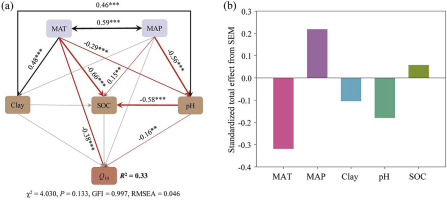Soil Biology and Biochemistry ( IF 9.7 ) Pub Date : 2019-11-19 , DOI: 10.1016/j.soilbio.2019.107675 Jinquan Li , Junmin Pei , Elise Pendall , Changming Fang , Ming Nie

|
The temperature sensitivity of soil respiration (Q10) plays a key role in benchmarking the intensity of terrestrial soil carbon-climate feedbacks. However, there is large spatial heterogeneity of Q10 that remains unexplained at the global scale. Here, we collected 480 estimates of Q10 values from field studies to explore the spatial heterogeneity of Q10 values and their controls at both global and regional scales. We used structural equation modeling to explore the direct and indirect factors and their relative importance predicting Q10 values at the global scale, and in different ecosystem types (i.e. forests and grasslands) and climatic zones (i.e. tropical, subtropical, temperate, and boreal). We found that mean annual temperature (MAT) was the most important factor in predicting field Q10 at the global scale, rather than mean annual precipitation (MAP) or soil properties (e.g. soil organic carbon (SOC) content). However, different dominant factors controlled Q10 in different ecosystems and climatic zones. Across forests, MAT was the dominant factor except in the tropics, where Q10 was mainly regulated by clay and SOC content. For grasslands, MAP, pH, and SOC were the most important factors in predicting Q10. These findings indicate that global field Q10 is mainly controlled by MAT, and this is inconsistent with most previous incubation experiments showing that soil properties are more important than climatic factors in predicting Q10 values. Moreover, recognizing different dominant factors of Q10 in different ecosystems and climatic zones improves our understanding of soil carbon-climate feedbacks in a warming climate.
中文翻译:

土壤呼吸温度敏感性的空间异质性:实地观测的整体分析
土壤呼吸的温度敏感性(Q 10)在基准陆地土壤碳-气候反馈强度中起着关键作用。但是,Q 10存在较大的空间异质性,在全球范围内尚无法解释。在这里,我们从现场研究中收集了480个Q 10值估计值,以探讨Q 10值的空间异质性及其在全球和区域范围内的控制。我们使用结构方程模型来探索直接和间接因素及其相对重要性,以预测Q 10全球规模,不同生态系统类型(即森林和草原)和气候带(即热带,亚热带,温带和寒带)的价值。我们发现年平均温度(MAT)是预测全球范围内田间Q 10的最重要因素,而不是年平均降水量(MAP)或土壤特性(例如土壤有机碳(SOC)含量)。但是,在不同的生态系统和气候区中,不同的主导因素控制着Q 10。在整个森林中,除了热带地区,MAT是主要因素,热带地区的Q 10主要受黏土和SOC含量的调节。对于草原,MAP,pH和SOC是预测Q 10的最重要因素。这些发现表明,全球田间Q 10主要受MAT控制,这与以前的大多数孵化实验不一致,后者表明土壤性质在预测Q 10值方面比气候因素更为重要。此外,认识到不同生态系统和气候区中Q 10的不同主导因素可以增进我们对变暖气候下土壤碳-气候反馈的理解。


























 京公网安备 11010802027423号
京公网安备 11010802027423号